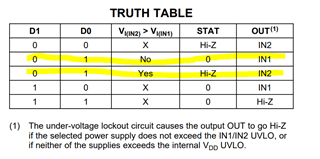Other Parts Discussed in Thread: TPS2115
Hi,
We are using TPS2115ADRBR in our system to manage two power supplies (VBUS and SYSTEM_PWR). We have followed the Auto-Selecting for a Dual Power Supply Application given on the datasheet.
PFA.,, Our Design for Power Management using TPS2115ADRBR
Also we have not used the Feedback resistor (R156).
For D1 is connected to GND, D0 is 'NC', Please find below table for the input and output voltages.
|
IN1
|
IN2
|
OUT
|
| 4.5V | 0V | 4.5V (IN1) |
| 0.88V | 3.6V | 1.68V |
| 4.5V | 3.7V | 4.5V (IN1) |
| 0.89V | 5V | 1.69V |
| 0V | 3.7V | 1.68V |
ie) Whenever IN2 > IN1, We did not get OUT from IN2 but as Undervoltage (~1.68V).
So we placed feedback resistor (R156), then we tested the iterations of input as above table. But we got the same outputs.
Please assist us in this regard. How to make IN2 as OUT, when (IN2 > IN1)?


